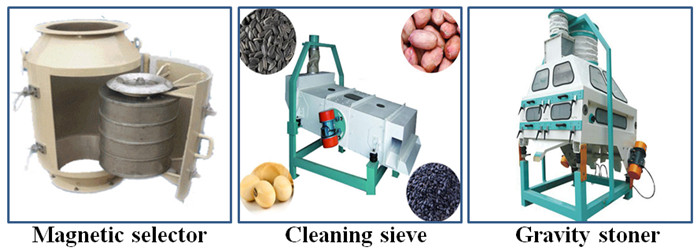The oil content of rapeseed is 37.5%-46.3%. Depending on the type of rapeseed, the oil content is slightly different. Rapeseed is one of the main oil crops in China, and its grain is one of the main varieties of raw materials for leaching oil. The rapeseed oil extraction process includes the cleaning and drying of rapeseed, heat treatment (steaming and frying), pressing and other processes. The following is the introduction of oil extraction equipment manufacturer Zhongxing's rapeseed oil extraction process.

Rapeseed oil extraction process:
1. Cleaning and drying of rapeseed
The rapeseed entering the edible oil factory will inevitably carry some impurities. If the dirt, stems and leaves entrained in the rapeseed are not removed, it will not only affect the quality of the oil and cake, but also absorb a part of the oil and reduce the oil yield of the rapeseed oil press. If the rapeseed is mixed with sand, stone, metal, hemp rope and other debris, it will cause the rapeseed oil press to wear out, etc., induce production accidents, and affect the rapeseed oil pressing process. Therefore, in order to ensure the smooth progress of the rapeseed oil pressing process, it is necessary to remove impurities as much as possible. For some rapeseed fruits with high water content, for the convenience of peeling, drying treatment is also required.
There are many ways to clean up rapeseed, and different methods can be used according to the impurities. If the impurities contained are light, such as grass, stems and leaves, the method of winnowing can be used to blow away the impurities with airflow. If the impurity particles are small, the impurity can be removed by selection. For some impurities that are similar in size and relative density to rapeseed, if they belong to mud blocks, they can be rubbed and crushed in a mud machine and then removed by screening. If it is iron impurity, it can be separated by electromagnet or permanent magnet. The impurity content after cleaning should be below.

2. Heat treatment (steamed and fried)
Heat treatment is one of the important steps in the process of oil extraction. Heat treatment includes the wetting and heating of the green billet, which is called steamed billet or fried billet in production, and the steamed billet is called cooked billet. The green pressed after heat treatment is called hot pressing, and the one without heat treatment is called cold pressing. Rapeseed oil pressing is mainly hot pressing. The effect of heat treatment has a direct impact on the smooth progress of the entire rapeseed oil extraction process, the level of rapeseed oil extraction rate, and the quality of oil products and cakes.
3. Squeeze
Screw oil press is a kind of rapeseed oil press widely used in rural small edible oil plants. The rapeseed oil press has simple structure, high pressure, can process materials continuously, has low labor intensity, and can squeeze a variety of oils. Because the round press bar of the rapeseed oil press has a zigzag curve and a cone, when the material is pressed, it is pushed and squeezed by the snail, so that the volume of the snail and the inner wall of the cage is constantly changing. Because of the arrangement of round press bars at the rear of the cage, the inner wall of the cage is in a zigzag shape, where the blanks are alternately pressed and relaxed. The structure of the blanks is constantly adjusted to be evenly turned, so that the unsqueezed oil or Preforms with less oil have a greater chance of being fully squeezed. Therefore, the use of spiral rapeseed oil press has better pressing effect.
Copyright © Henan Zhongxing Grain And Oil Machinery Co.,Ltd. All Rights Reserved. Powered by MetInfo